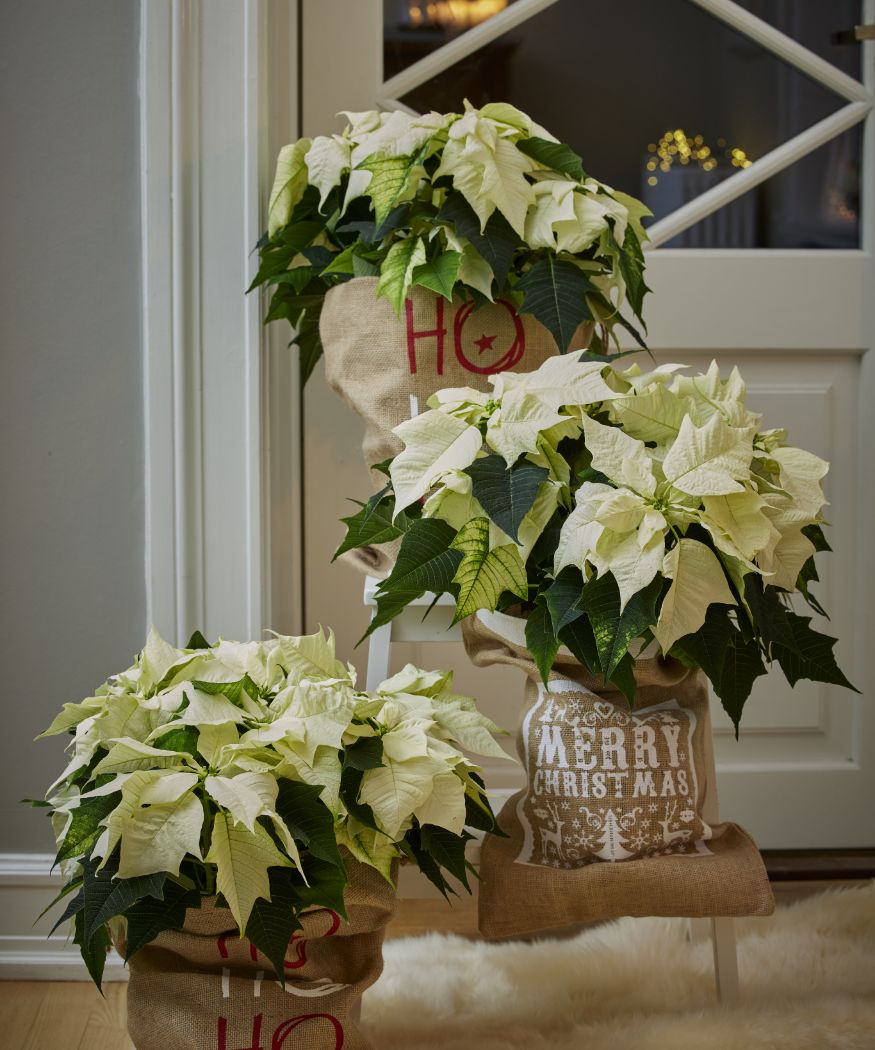- 04.09.2023 /
- Care /
- Interesting facts

Their magnificent bracts, which come in various colours, shapes and sizes, add a distinctive touch to any room and create a cosy feel on grey autumn and winter days. The experts at Stars for Europe (SfE) know what tips to use to keep your poinsettias healthy and strong and to maintain their brilliant colours well into the New Year.
Buy plants with the best chance of growth
The wild form of our poinsettias comes from Mexico. In the tropical climate of this Central American country, the plants grow into metre-high shrubs. They have passed on their preference for light and warmth to the modern cultivated forms. Darkness, draughts and cold are poison for poinsettias. So when buying, make sure the plants are displayed in an appropriate place. Poinsettias placed in a dark corner of a shop, a draughty entrance area or outside in temperatures below 15°C usually lose their leaves within a few days of purchase and often die shortly afterwards.
You can recognise a healthy poinsettia with the best chance of a long life by its vigorous, dense foliage that has no damage and budding, yellow-green flowers in the centre of the coloured bracts. The soil should be neither dried out nor soaking wet. The experts at SfE also advise against buying glittered plants. As beautiful as the sparkle may be, it’s not good for poinsettias or our environment.
Wrap up and go home quickly
After purchasing, wrap your poinsettia well and bring it home quickly. Specialist shops, such as garden centres and nurseries, usually offer free wrapping material to protect your plants during transport. At outside temperatures below 15°C, make full use of this offer. Even at higher temperatures, wrapping poinsettias protects them from draughts too. The more layers of paper you wrap around your plant, the better it will be insulated against the cold. In sub-zero temperatures, wrap the pot too, as neither it nor the soil offer enough protection for the sensitive roots. If you’re transporting your poinsettia in the car, avoid long stops on frosty days. Without heating, it quickly gets very cold in a car – and even well-wrapped plants won’t survive this for long.
Slowly get your plant used to the new ambient temperature
When you get home, quickly remove the wrapping from your poinsettia. To make the transition from cold to warm as stress-free as possible for the plant, it’s best not to move it immediately into a warm room. In a cooler, lighter room such as the kitchen or conservatory, your poinsettia can acclimatise in peace. After a few hours move it to its final location.
Choose a suitable spot
The perfect location is bright, warm and protected from draughts and large temperature fluctuations. For example, a place right next to the front door isn’t suitable. The ideal room temperature is between 15-22°C. In principle, there’s nothing wrong with placing your poinsettia next to a well-insulated window. However, it’s important to move it to a sheltered spot when airing your room, so it doesn’t suffer from draughts.
On windowsills, a saucer under the pot protects your plant from getting ‘cold feet’. Poinsettias like it warm, but not too hot. A spot right next to a radiator or stove isn’t ideal, because poinsettias react easily to excessive temperatures by shedding their leaves. Basically, the warmer it is, the more water the plant needs.
Water moderately on a regular basis
Poinsettias can tolerate slight dryness better than too much moisture. Only when the top of the soil has dried out is it time to water. The inside of the root ball should never dry out. It’s impossible to give a definitive answer on often to water. As well as the ambient temperature and humidity, important factors include the size of the pot, for example. Mini poinsettias in 6cm pots need water more often than plants in 12-13cm pots, because of their smaller soil volume.
Poinsettias can be watered from above, below or by immersion. Ideally, use room temperature water. When watering from above, give small amounts every two to three days until the root ball is evenly moist without being completely soaked. When watering from below, pour the water into the planter or saucer. The soil will absorb as much as the poinsettia needs. Keep adding water until the root ball is soaked and liquid remains in the saucer. When immersing the almost dry root ball, submerge it completely about once a week until the water stops bubbling.
Then quickly lift the poinsettia, let it drain and put the plant back in the planter. With all three methods it’s important to remove excess water from the saucer or planter no more than 15 minutes later to avoid waterlogging and root damage.
